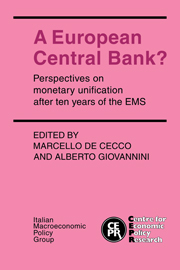Book contents
- Frontmatter
- Contents
- List of figures
- List of tables
- Preface
- List of conference participants
- 1 Does Europe need its own central bank?
- 2 Monetary policy, capital controls and seigniorage in an open economy
- 3 Seigniorage in Europe
- 4 Factor mobility, uncertainty and exchange rate regimes
- 5 Management of a common currency
- 6 The tastes of European central bankers
- 7 The costs and benefits of a European currency
- 8 The monetary unification process in nineteenth-century Germany: relevance and lessons for Europe today
- 9 The establishment of a central bank: Italy in the nineteenth century
- 10 The founding of the Fed and the destabilization of the post-1914 US economy
- 11 Panel discussion on the prospects for a European Central Bank
- Index
4 - Factor mobility, uncertainty and exchange rate regimes
Published online by Cambridge University Press: 05 February 2012
- Frontmatter
- Contents
- List of figures
- List of tables
- Preface
- List of conference participants
- 1 Does Europe need its own central bank?
- 2 Monetary policy, capital controls and seigniorage in an open economy
- 3 Seigniorage in Europe
- 4 Factor mobility, uncertainty and exchange rate regimes
- 5 Management of a common currency
- 6 The tastes of European central bankers
- 7 The costs and benefits of a European currency
- 8 The monetary unification process in nineteenth-century Germany: relevance and lessons for Europe today
- 9 The establishment of a central bank: Italy in the nineteenth century
- 10 The founding of the Fed and the destabilization of the post-1914 US economy
- 11 Panel discussion on the prospects for a European Central Bank
- Index
Summary
Early contributions to the theory of ‘Optimal Currency Areas’ focused on the different efficacy of stabilization policy in different nominal exchange rate regimes, and on the relevance of imperfect factor mobility to the economy's ability to respond to disturbances in the presence of nominal rigidities (Mundell, 1961; McKinnon, 1963). The debate on the desirability of fixed exchange rates has since focused on stabilization policy, disregarding the microeconomics of factor reallocation.
Issues of factor mobility have been studied in the real trade literature but, in most cases, under certainty. Recent advances in the microeconomic theory of costly reallocation under uncertainty have shown that the degree of uncertainty about the future, as well as the size of adjustment costs, is an important determinant of the propensity to reallocate resources in response to disturbances. The more uncertain is their environment, the greater should be the reluctance of rational economic agents to undertake adjustments that may ex-post be regretted.
In order to provide new theoretical foundations to the old arguments for and against nominal exchange rate stability, these partial-equilibrium insights would have to be combined with a better understanding of the sources of macroeconomic instability and of the stabilizing role of monetary policy in different exchange rate regimes. Any analysis of stabilization policy presupposed instability in the environment and should, consequently, take explicit account of uncertainty. This paper takes a first step towards this new area of research.
- Type
- Chapter
- Information
- A European Central Bank?Perspectives on Monetary Unification after Ten Years of the EMS, pp. 95 - 130Publisher: Cambridge University PressPrint publication year: 1989
- 5
- Cited by



